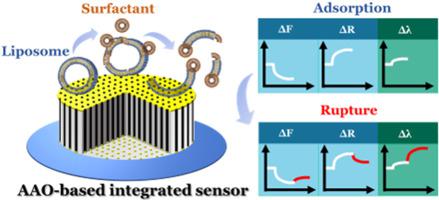Sensing and Bio-Sensing Research ( IF 5.4 ) Pub Date : 2021-03-23 , DOI: 10.1016/j.sbsr.2021.100415 Naoto Asai , Naohiro Matsumoto , Ichiro Yamashita , Tomohiro Shimizu , Shoso Shingubara , Takeshi Ito

|
Liposomes have been attracted attention, because liposomes can mimic the lipid bilayer membrane of cells. Scientists apply liposomes for drug delivery systems (DDSs) and for artificial cells. Hence, the handling of liposomes is very important. In particular, it is difficult to control the adsorption of the liposome onto the target selectively and the release of the drug by its own rupture. Therefore, scientists are looking for the way to carefully monitor the behavior of liposomes from adsorption to rupture in deep.
We integrated quartz crystal microbalance dissipation (QCM–D) and localized surface plasmon resonance (LSPR) into a single sensor and monitored the signals from the sensor on the adsorption and rupture of liposome. The integrated sensor detected resonance frequency and dissipation from QCM-D, and wavelength shifts from LSPR simultaneously. The integrated sensor successfully monitored conformational changes of liposomes in real time upon exposure to the surfactant, Triton X-100. The data clearly revealed liposome adsorption and deformation, and disruption of membrane integrity by normalizing three signals, resonance frequency, resonance resistance and wavelength shift. In fact, we found that normalized signals were divided into 5 steps through the experiment: liposome adsorption, liposome deformation slightly, liposome conjugated with micelles of surfactant, liposome disruption and lipid bilayer covered on the surface. These results indicate that our device provides a powerful tool to gain deeper insights into biomolecular interactions, expanding numerous applications such as monitoring of conformational changes in proteins, oligonucleotides, viruses, bacteria, vesicles, and cells.
中文翻译:

通过LSPR和QCM-D集成传感器监测脂质体在液-固界面上的吸附及其破裂的详细分析
脂质体已经引起人们的关注,因为脂质体可以模拟细胞的脂质双层膜。科学家将脂质体用于药物递送系统(DDS)和人工细胞。因此,脂质体的处理非常重要。特别地,难以选择性地控制脂质体在靶上的吸附以及通过其自身的破裂来释放药物。因此,科学家正在寻找一种方法来仔细监测脂质体从吸附到深层破裂的行为。
我们将石英晶体微天平耗散(QCM-D)和局部表面等离振子共振(LSPR)集成到单个传感器中,并监控来自传感器的脂质体吸附和破裂信号。集成传感器检测QCM-D的共振频率和耗散,同时检测LSPR的波长偏移。集成的传感器在暴露于表面活性剂Triton X-100后实时成功监测了脂质体的构象变化。数据清楚地显示了脂质体的吸附和变形,并通过归一化三个信号(共振频率,共振电阻和波长偏移)破坏了膜的完整性。实际上,我们通过实验发现归一化的信号分为5个步骤:脂质体吸附,脂质体轻微变形,脂质体与表面活性剂的胶束,脂质体破坏和表面覆盖的脂质双层共轭。这些结果表明,我们的设备为深入了解生物分子相互作用提供了强大的工具,扩展了许多应用程序,例如监测蛋白质,寡核苷酸,病毒,细菌,囊泡和细胞的构象变化。











































 京公网安备 11010802027423号
京公网安备 11010802027423号